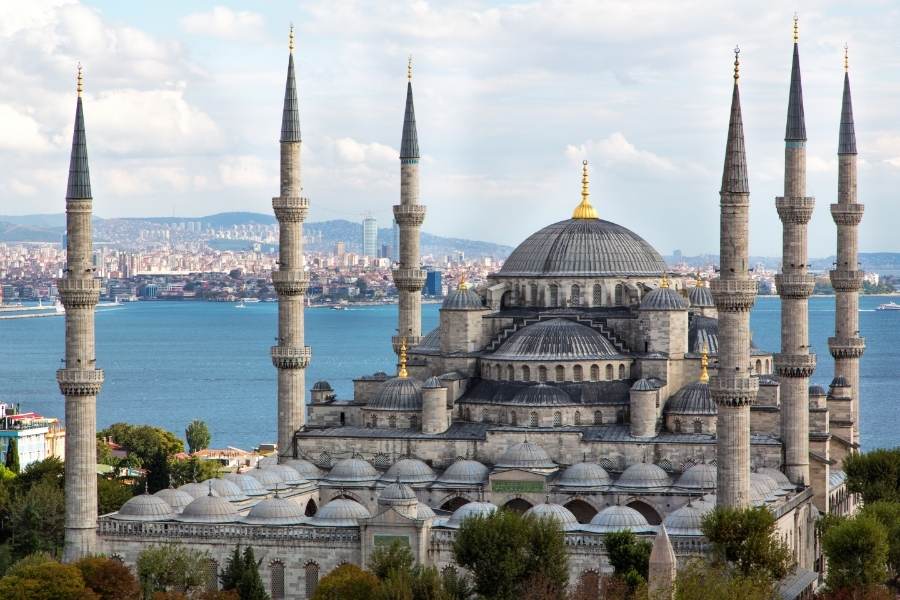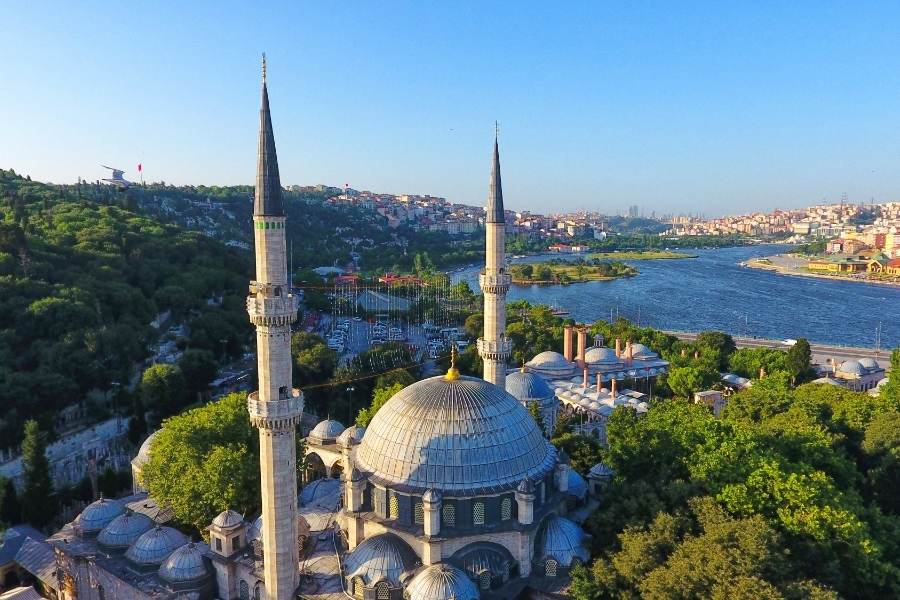9 Beautiful Mosques Not to Miss in Istanbul
Discover the architectural marvels of Istanbul's beautiful mosques

Among Istanbul’s many tourist attractions, mosques take the lead as historical landmarks and architectural marvels. Here we've listed some of the most beautiful mosques not to miss in Istanbul.
Straddling Europe and Asia, the city of Istanbul is a bridge between civilizations. Istanbul’s rich cultural heritage can be seen in its architecture, and mosques are great architectural landmarks.
There are around 3,000 mosques in Istanbul, most of which are inseparable parts of the city’s unforgettable silhouette by the Bosporus strait. Exhibiting various cultural and architectural elements, Istanbul’s mosques definitely worth visiting.
So, what are the most beautiful mosques in Istanbul?
The 9 Most Beautiful Mosques in Istanbul
1. Sultanahmet / Blue Mosque

With its six slim minarets piercing Istanbul’s skyline, The Sultanahmet Mosque is a great architectural example of the classical Ottoman period.
This mosque is referred to as The Blue Mosque because of the beautiful hand-painted blue İznik tiles adorning its interior. When the light enters through the mosque’s 260 stained glass windows and shines more than 20,000 tiles, the massive mosque’s interior is bathed in blue.
The mosque was completed in 1616, during the rule of Sultan Ahmed I. Designed to outshine the Hagia Sophia standing across, the Sultanahmet Mosque incorporates Byzantine elements along with traditional Islamic architecture.
The architects were influenced by Hagia Sophia’s dome structure but planned the exterior to be more ornate. The interior is also decorated with flower figures that are symbolic of Islam.
Whereas most mosques mostly have four minarets, Sultanahmet Mosque exceptionally has five main domes, six minarets, and eight secondary domes. The mosque complex comprises a tomb of the Sultan, a madrasa, and a hospice.
The Sultanahmet Mosque is still open to prayers five times a day, as well as visits from thousands of tourists every year.
2. Aya Sofya / Hagia Sophia Mosque

Hagia Sophia is one of the greatest surviving examples of Byzantine architecture. The construction of this historical and architectural landmark is said to have changed the history of architecture, mostly because of its massive dome.
Materials used in the construction of this structure had been brought from all over the world, including yellow stones from Syria, red marble from Egypt, and Hellenic Columns from the Artemis Temple in Ephesus.
After being built in the 6th century as a cathedral for the Byzantine Empire, the building was converted into a mosque under Ottoman rule in 1453. It served as a museum from 1932 to 2020, and now it’s an active mosque open to visits.
Featuring both Christian and Islamic elements, this mosque is a unique architectural masterpiece not to miss while you’re in Istanbul. Its inner walls are in beautiful shades of grey and blue, and the yellow domes are covered with elaborate mosaics.
The beautifully carved doors, the narthexes, the remains in its garden, and Islamic additions like lodges, the four minarets, and the mausoleums of Ottoman Sultans are equally fascinating.
3. Eyüp Sultan Mosque

Eyüp Sultan Mosque was the first mosque built after the conquest of Istanbul by the Ottomans, but the mosque complex was completed over a long period of time, incorporating various architectural styles.
During its reconstruction in 1800, architects chose to implement the Baroque style and a stone color reflecting hues of golden and amber. It has one large dome measuring 57.5 feet across, with two half domes for support.
The mosque is located outside the city walls near the Golden Horn. The mosque complex also includes a mausoleum of Abu Ayub al-Ansari (Eyüp), the standard-bearer, and a friend of the Islamic Prophet Muhammad. The tomb is decorated with beautiful hand-painted İznik tiles in all shades of blue.
Eyüp Sultan Mosque was the traditional site for the Ottoman Sultans’ coronation ceremony. This mosque is deemed more sacred than a usual place of worship among the Islamic world.
4. Ortaköy / Büyük Mecidiye Mosque

This striking Neo-Baroque mosque standing right by the sea adorns the Bosphorus silhouette like a piece of lace. Anyone crossing the bridge over Ortaköy is impressed by this white, elegant structure.
This mosque has an ornate exterior and a plain interior. Large windows allow light with shades of blue from the Bosporus into the mosque. The high ceiling is a dome shape, covered in pink mosaics.
The current Büyük Mecidiye Mosque was completed in 1856 by Garabet Amira Balyan and Nigoğayos Balyan, the Armenian father and son architects who also designed the Dolmabahçe Palace and its mosque. Inside the mosque, there are several panels of calligraphy executed by Abdülmecid I himself.
5. Süleymaniye Mosque

The Süleymaniye Mosque was the largest in Istanbul until 2019 with its staggering size. Its central dome stands 154ft high. It was built in the 16th century by the famous Ottoman architect Mimar Sinan for Sultan Süleyman the Magnificent.
Byzantine elements such as large domes and slim minarets from Islamic architecture are combined beautifully in this complex. With the restorations, Baroque elements were also added to the design.
The interior is elegantly decorated, underlining a sense of space and light. Although less ornate than most mosques, this impressive structure is one of the best works of Ottoman Islamic architecture in Istanbul.
This grand mosque is located on the third hill of Istanbul and includes a hospital, a library, madrasa (schools) and soup kitchens, hammams, and shops. Later on the mausoleums of the Sultan, his wife Hürrem, and Mimar Sinan were added within the complex.
6 & 7. Mihrimah Sultan Mosques

The two Mihrimah Sultan mosques on two sides of Istanbul are located in perfect symmetry to each other. These two historical 16th-century structures hide an architectural wonder and a hopeless love story in their walls.
The mosques were commissioned by Mihrimah Sultan, the daughter of Sultan Süleyman the Magnificent, and designed by the imperial architect Mimar Sinan. And Mimar Sinan, who was hopelessly in love with the Sultan, carved his love into his genius designs. Note that Mihrimah (Mihr-u Mâh) means “sun and moon” in Persian, and you’ll see how.
If you stand on a location where you can see both mosques, on March 21 of every year (Mihrimah Sultan’s birthday and the Spring equinox), you’ll see the sun setting behind the only minaret of the mosque in Edirnekapı, and the moon rising between the minarets of the mosque in Üsküdar. This is a perfect representation of the Sultan’s name and Sinan’s love for her.
Also, the Üsküdar mosque was built with few windows to symbolize the moon, whereas the Edirnekapı mosque’s several windows symbolize the sun. The Edirnekapı mosque has one minaret to symbolize Sinan’s loneliness (although he was married to someone else at the time).
The mosque in the Üsküdar district (also called İskele Camii/ the Pier Mosque) was the first one to be built, and the Mihrimah Sultan Mosque in Fatih, Edirnekapı was the second one.
8. Şemsi Paşa / Kuşkonmaz Mosque

This tiny mosque by the ferry docks in Üsküdar is one of the less famous mosques in the city. However, it’s another prime example of Mimar Sinan’s architectural genius and one of the most interesting buildings in Istanbul.
Married to Mihrimah Sultan's daughter, Grand Vizier Şemsi Pasha commissioned this mosque, making an unusual request to the imperial architect Mimar Sinan.
Şemsi Paşa wanted no birds to fly over (and defecate on) his mosque. Sinan found the perfect spot for the mosque in Üsküdar, where northern and southern winds ogle at each other, making it impossible for birds to fly in the sky. Sinan also believed that the sounds and vibrations caused by the waves breaking at the walls by the sea would disturb the birds and keep them away.
Sinan was ninety years old when he accomplished Şemsi Paşa’s impossible wish, but Şemsi Pasha didn’t live to see the mosque finished. The mosque opened one year after his death, and he was buried in it.
The name “Kuşkonmaz” means “where no birds land,” and no birds have ever settled on the Şemsi Paşa Mosque since 1580.
9. Sancaklar Mosque

At this point, you’ve seen a lot of historical mosques in Istanbul. Now, this modern mosque will fascinate you with its unique and unusual architecture.
Built in 2012 by architect Emre Arolat in Büyükçekmece, this striking mosque was awarded the Religious Building of the Year Award for 2015 by ArchDaily.
Sancaklar Mosque is located in a prairie landscape separated from the surrounding suburban gated communities by a busy highway. Unlike the traditional mosques rising high from the ground, their minarets piercing the sky, this underground building is almost invisible from above and blends in entirely with the topography.
The mosque’s interior is a simple cave-like space, and the whole design is primeval, in a sense. But the serene atmosphere of the unusually plain structure allows one to feel alone with God, taking worship up to a meditative level.
This extraordinary mosque was also the main character in a movie titled Rüya (Dream) by the acclaimed Turkish writer and director Derviş Zaim.
Closing Notes
From traditional to modern, mosques in Istanbul are a monumental cultural heritage for ages. But as they are also places of worship, we kindly remind you that there are rules to be followed when visiting a mosque.
Avoid praying times planning your visit, and dress accordingly. Don’t wear shorts or short skirts, or sleeveless tops. Women should also cover their heads, shoulders, and arms with a scarf or a shawl.
Here we’ve listed only some of the architectural marvels of the city. There are many other striking mosques that remain to be seen in Istanbul. We hope that you’ll enjoy discovering these monumental spiritual places.